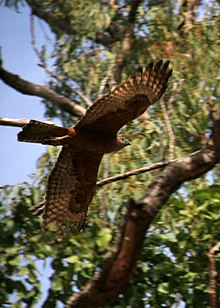
Hawks are birds of prey of the family Accipitridae. They are very widely distributed and are found on all continents except Antarctica.
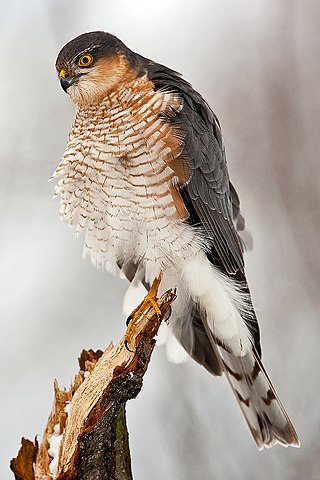
Accipiter is a genus of birds of prey in the family Accipitridae. With around 50 recognized species it is the most diverse genus in its family. Most species are called goshawks or sparrowhawks, although with the exception of the American goshawk almost all New World species are simply known as "hawks". They can be anatomically distinguished from their relatives by the lack of a procoracoid foramen. Two small and aberrant species usually placed here do possess a large procoracoid foramen and are also distinct as regards DNA sequence. They may warrant separation in the old genus Hieraspiza.

The Accipitrinae are the subfamily of the Accipitridae often known as the "true" hawks. The subfamily contains 73 species that are divided into 11 genera. It includes the genus Accipiter which formerly included many more species. The large genus was found to be non-monophyletic and was split into several new or resurrected genera. The birds in this subfamily are primarily woodland birds that hunt by sudden dashes from a concealed perch, with long tails, broad wings and high visual acuity facilitating this lifestyle.

The shikra is a small bird of prey in the family Accipitridae found widely distributed in Asia and Africa where it is also called the little banded goshawk. The African forms may represent a separate species but have usually been considered as subspecies of the shikra. The shikra is very similar in appearance, as well as behavior, at least to some degree, to other species including the Chinese sparrowhawk, Eurasian goshawk and Eurasian sparrowhawk. They have a sharp two note call and have the typical flap and glide flight. Their calls are imitated by drongos and the common hawk-cuckoo resembles it in plumage. This species was formerly placed in the genus Accipiter.

The red goshawk is probably the rarest Australian bird of prey. It is found mainly in the savanna woodlands of northern Australia, particularly near watercourses. It takes a broad range of live prey, mostly birds.

The crested goshawk is a bird of prey in the family Accipitridae that is widely distributed in tropical Asia. It was formerly placed in the genus Accipiter.

Doria's hawk or Doria's goshawk is a raptor in the family Accipitridae that lives in the Indonesia and Papua New Guinea areas. It is the only species placed in the genus Megatriorchis. Within the family, it is relatively large in size with up to 69 cm long with the female being larger in size than the male.

The brown goshawk is a medium-sized bird of prey in the family Accipitridae found in Australia and surrounding islands. This species was formerly placed in the genus Accipiter.

The grey goshawk is a strongly built, medium-sized bird of prey in the family Accipitridae that is found in eastern and northern Australia. The white morph of this species is known as the white goshawk. This species was formerly placed in the genus Accipiter.
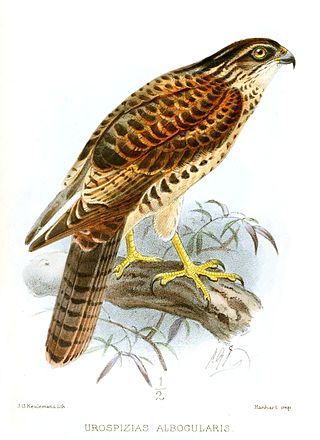
The pied goshawk is a species of bird of prey in the family Accipitridae. It is found on Bougainville Island and the Solomon Islands. Its natural habitats are subtropical or tropical moist lowland forest and subtropical or tropical moist montane forest. This species was formerly placed in the genus Accipiter.

The black-mantled goshawk is a species of bird of prey in the family Accipitridae. It is found in the highlands of New Guinea. Its natural habitat is subtropical or tropical moist lowland forests. This species was formerly placed in the genus Accipiter.

The little sparrowhawk is a species of Afrotropical bird of prey in the family Accipitridae. It was formerly placed in the genus Accipiter. It is the smallest member of the genus Tachyspiza and forms a superspecies with the red-thighed sparrowhawk.
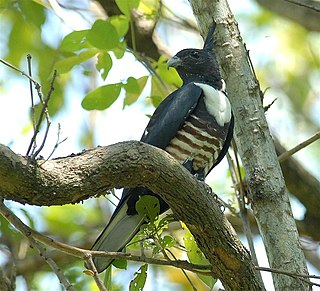
The bazas, Aviceda, are a genus of bird of prey in the family Accipitridae. The genus has a widespread distribution from Australia to southern Asia and across to Africa. The bazas are sometimes known as cuckoo-hawks. A prominent crest is a feature of the bazas. They have two tooth-like indentations on the edge of the upper bill.
The chestnut-shouldered goshawk is a species of bird of prey in the family Accipitridae. It is found in New Guinea.
The black honey buzzard, also known as the New Britain honey buzzard, is a large raptor of the family Accipitridae. Standing at around 50 cm (20 in) tall, the adult black honey buzzard has a dark head and body, with striking white bands on its tail and flight feathers. When in flight, the buzzard can be recognized by its long wings and noticeably large secondary feathers. It is thought to be sedentary, with a range limited to the island of New Britain in Papua New Guinea, where it is endemic. Due to its remote habitat and tendency to remain in densely forested areas, there is still much to learn about this striking species.
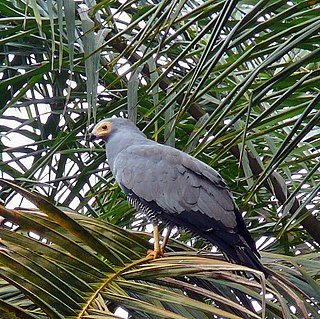
Polyboroides is a genus of bird of prey in the family Accipitridae. This genus has two recognized species found in Sub-Saharan Africa and Madagascar. The two species are allopatric and restricted to the Afrotropical realm. They are generally known as harrier-hawks.
Goshawk may refer to several species of birds of prey, mainly in the genus Accipiter:

Lophospiza is a genus of Asian birds of prey in the family Accipitridae. It is the only genus in the subfamily Lophospizinae. The two species placed in this genus were formerly placed in the genus Accipiter.

Astur is a genus containing hawks, goshawks and sparrowhawk in the family Accipitridae. The species were formerly placed in the genus Accipiter.

Aerospiza is a genus containing goshawks and a sparrowhawk in the family Accipitridae that are found in Africa. The three species in the genus were formerly placed in the genus Accipiter.
